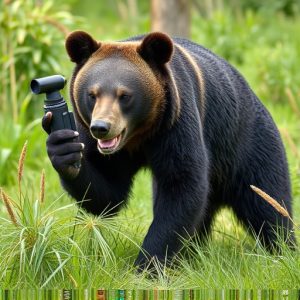Bear Spray Range: Understanding Effectiveness Beyond 30 Feet & Storage Tips
Understanding bear spray range is vital for safety in bear country. While effective up to 30 feet, f…….
Understanding bear spray range is vital for safety in bear country. While effective up to 30 feet, factors like wind, terrain, and temperature can impact its reach. Contrary to myth, bear spray doesn't freeze at cold temperatures due to its aerosol design. Freezing risk arises only with extreme low temps, requiring storage above 40°F (4.4°C) and separation of sprayed and unsprayed cans to prevent canister damage.
“Bearing the brunt of a bear encounter can be terrifying. Enter bear spray, touted as a crucial defense mechanism. While commonly believed to have a thirty-foot effective range, this article delves deeper into the intricacies. We explore factors that influence its reach beyond the surface mark, from weather conditions to angle of use. Furthermore, we address storage concerns, including whether extreme cold can freeze bear spray and compromise its performance. Understanding these nuances is vital for ensuring your safety in potential encounters.”
- Understanding Bear Spray Range: What You Need to Know
- Factors Influencing Effective Range: Beyond Just Thirty Feet
- Storage Considerations: Can Bear Spray Freeze and Affect Its Performance?
Understanding Bear Spray Range: What You Need to Know
Understanding Bear Spray Range: What You Need to Know
Bear spray is a powerful deterrent designed to protect against aggressive bears. Its effectiveness lies in its range—typically around thirty feet (10 meters). This distance offers users a crucial moment to escape or defend themselves should they encounter a bear. However, it’s essential to remember that the spray’s range isn’t absolute; factors like wind, terrain, and the user’s movement can affect its reach.
When considering bear spray, another critical aspect is its performance in cold environments. Contrary to some myths, bear spray does not freeze at typical winter temperatures. It remains effective down to very low temperatures, ensuring you have a reliable defense during outdoor activities in colder regions. Understanding these dynamics is vital for anyone venturing into bear country, as it empowers them to make informed decisions about their safety and the tools they carry.
Factors Influencing Effective Range: Beyond Just Thirty Feet
While bear spray is effective up to a thirty-foot range, several factors can influence its performance beyond this mark. One key consideration is temperature—both during storage and deployment. Unlike liquid sprays that may freeze in cold environments, bear spray is designed as an aerosol, which makes it less susceptible to freezing point issues. However, extremely low temperatures can still affect the spray’s consistency and range.
Another factor is wind. A gusty day can significantly reduce the effective range of any spray, not just bear spray. Additionally, terrain plays a role; rough or uneven ground can disrupt the spray pattern and cause it to deviate from its intended path. These variables underscore the importance of understanding local conditions when considering the effectiveness of bear spray beyond the stated thirty-foot range.
Storage Considerations: Can Bear Spray Freeze and Affect Its Performance?
Bear spray is a valuable tool for outdoor enthusiasts and individuals living in areas prone to bear encounters, but proper storage is essential to maintain its effectiveness. One common concern is whether bear spray can freeze during storage, especially in colder climates. Freezing temperatures can indeed impact the performance of bear spray, as it may cause the canister to become rigid or even crack under extreme cold conditions. This issue arises because bear spray is typically a liquid solution stored under pressure, and freezing water expands, potentially damaging the canister’s integrity.
To prevent this from happening, it’s crucial to store bear spray in a warm environment, ideally above 40°F (4.4°C). Many manufacturers recommend keeping canisters indoors or in heated storage areas during cold months. Additionally, proper labeling and rotation of inventory are essential practices. Storing sprayed cans separately from unsprayed ones can help prevent contamination or accidental activation due to freezing temperatures. Regularly checking the condition of bear spray before each use is a good habit to ensure it remains functional when needed.
Bear spray is an essential tool for outdoor enthusiasts navigating potential bear encounters, with an advertised effective range of thirty feet. However, understanding the factors influencing this range and proper storage considerations, such as preventing freezing, are crucial to ensure its effectiveness when needed. By being aware of these aspects, users can maximize the reliability of their bear spray as a deterrent in various environments.


